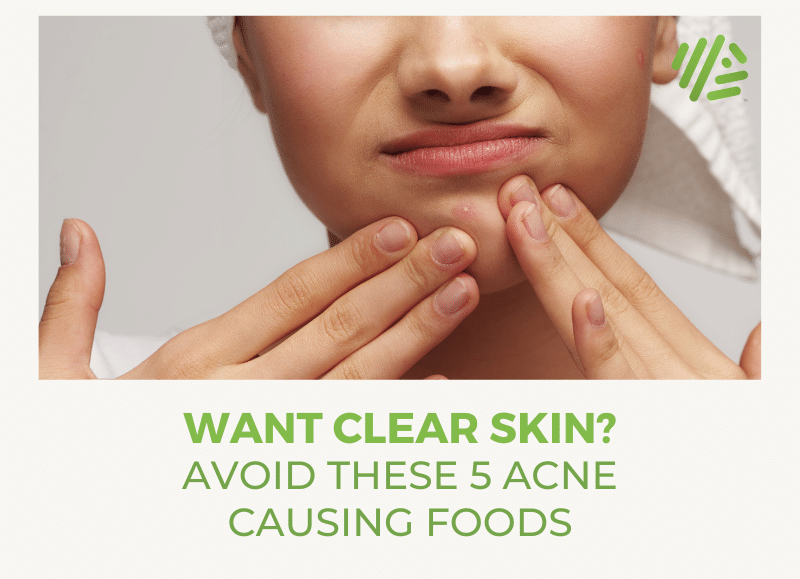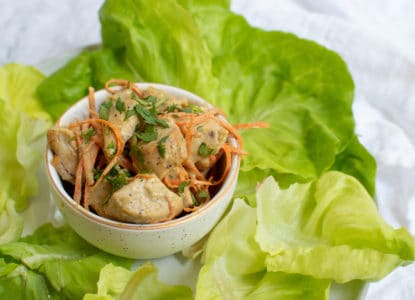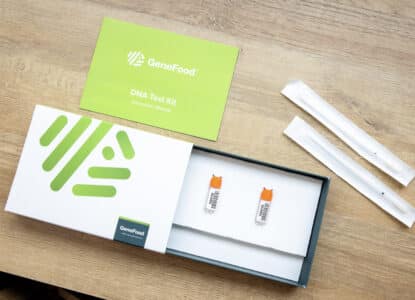Want Clear Skin? Avoid These 5 Acne Causing Foods
Article at a Glance
- Milk and dairy, whey protein, eggs, Vitamin B12, and damaged vegetable oils are all some of the worst offending foods that lead to acne and outbreaks. Read on to learn more and tour some of the most important research!

Contents
When it comes to the most common foods that cause acne, chocolate gets a particularly bad rap. Is that reputation fair though? In this article I’ll dig into five foods that cause acne, and give you a bit of background on why.
In my book, Eat to Beat Acne, I had good fun debunking many myths around skin health. What I hope readers take away from the book is a clearer sense that things aren’t always black and white when thinking about, well, blackheads and whiteheads. We can’t just say that chocolate causes acne or doesn’t cause acne and leave it at that. Instead, we have to understand how certain foods (including, yes, chocolate!) can upset the body’s balance and contribute to spotty skin.
There’s no single cause of acne or even a straightforward process. Nor is there a straightforward treatment. Instead, acne develops as a result of multiple processes, many of which overlap and feed into each other.
So, in the name of clearer skin, let’s consider five foods that cause acne and why, with the caveat that no single food leads to an acne outbreak.

Get Started With Personalized Nutrition
Gene Food uses a proprietary algorithm to divide people into one of twenty diet types based on genetics. We score for cholesterol and sterol hyperabsorption, MTHFR status, histamine clearance, carbohydrate tolerance, and more. Where do you fit?
#1. Milk and many other dairy products
A cup of 1% fat milk contains 13 grams of sugar. A cup of 2% contains 12 grams. That’s less than a can of soda, but still a decent whack of sugar. Now, add to that the naturally present growth hormones in milk (and any added hormones) and it’s easy to see how milk can promote hormone changes in people.
In my deep dive into acne science, I talk about the steroid hormone DHT, which is one of the most potent androgens and a primary mechanism for acne development. Surprise, surprise, milk contains both 5a-androstanedione, and 5alpha-pregnanedione (5alpha-P) which are direct precursors of DHT 12. Epidemiological research links dairy consumption not only with acne and prostate issues, but also with breast cancer as 5alpha-P increases sensitivity to estrogen in breast tissue 3.
Some of the other reasons that have been proposed to explain the dairy-acne link include:
- Adverse effects of dairy on the gastrointestinal system.
- Increased inflammation from lactose intolerance.
- Impaired absorption of beneficial nutrients due to GI distress.
- Abnormally high levels of some hormones, particularly testosterone, in many low-fat dairy products.
- Antibiotic residues that can lead to antibiotic resistance and microbiome disruption
- Bacterial contamination from cows with mastitis, and/or fecal contamination.
- Pesticide residues.
- Excess iodine in dairy.
Interestingly, dairy intake in high school is associated with increased risk of severe teenage acne 5. This large retrospective analysis used data from the Nurses Health Study II and found a significant association between reported intake of dairy foods during high school and physician-diagnosed severe teenage acne.
This landmark study involved data from some 47,355 women who completed questionnaires on high school diet. After accounting for age, age at menarche, body mass index, and energy intake, acne prevalence increased 22% when milk intake was excessive, by 12% for whole milk, by 16% for low-fat milk, and by a whopping 44% for skim milk. Instant breakfast drink, sherbet, cottage cheese, and cream cheese were also positively associated with acne.
All in all, it’s not that surprising really that the ideal food for a rapidly growing baby cow isn’t ideal for hormone balance in the average human.
#2. Highly refined carbohydrates
Remember how I talked about the vilification of chocolate as a cause of acne? Well, in some cases, chocolate may well be a contributing factor. That’s because there’s plenty of chocolate around that contains high levels of dairy and refined sugar.
Refined or simple carbohydrates such as those in chocolate, white bread, pasta, and baked goods using white flour can lead to insulin spikes, inflammation, and androgen imbalance – the primary mechanisms behind acne. Other foods that contain high levels of refined sugar, maltose, dextrose, fructose, and other simple sugars are also likely to trigger some of these mechanisms.
Fruit is something of an exception in that most servings of fruit contain less than 10 g of carbohydrate and usually contain plenty of soluble fiber which slows down sugar absorption to prevent insulin spikes. Clearly, you’ll want to stay away from refined fructose products, such as high fructose corn syrup. Fruit juices are also typically high in sugar, with little fiber to slow down the absorption of that sugar.
One of the best things you can do to combat acne, then, is to look at sources of sugar in your diet. Ditch these and you’ll probably notice a range of improvements in health, including in your skin health.
This was seen in one single-blinded, parallel intervention study involving teens and young-adults with acne. After eating a low GI diet for just 12 weeks, participants experienced dramatic improvements in acne 6. The trial involved 43 men aged 15-25 who followed a low-glycemic-load diet composed of 25% energy from protein and 45% from low-glycemic-index carbohydrates, while a control group ate a diet that emphasized carbohydrate-dense foods without any mention of the glycemic index.
In the same study, the low GI group also had a decrease of 23.5 in acne lesions, compared to a reduction of just 12 in the control group. Insulin sensitivity was also improved in the low GI group, offering further advantages for skin health and general well-being.
#3. Whey protein
Yes, yes, whey protein is technically a dairy product, but when it comes to acne, whey deserves special mention all of its own.
Whey is the liquid fraction of processed cow’s milk (the curds are the solids). Whey is then processed into powder form, with protein isolated or concentrated from the raw liquid. The result is typically high in casein and in vitamin B12 (see below for why this might be a problem for acne sufferers).
Although actual research linking acne to whey is scarce 7, there’s plenty of evidence that whey triggers at least one of the mechanisms that causes acne. Whey is well known to increase insulin production and insulin-like growth factor-1. This goes on to stimulate sebum production and keratinization, creating the conditions for acne development. A handful of small studies report rapid resolution of acne when people stop taking whey protein, with one study finding that acne recurred when one individual began taking whey protein again. 8 9
#4. Vegetable oils (especially damaged ones!)
Vegetable oils are typically high in omega-6 fatty acids, which are precursors to pro-inflammatory mediators. While the body needs some of these to stay healthy, the standard American diet is far too high in omega-6 compared to omega-3.
Omega-6 has been linked to the development of inflammatory acne 10. In contrast, omega-3 fatty acids can decrease IGF-1 levels 11. This suggests that correcting the typical imbalance in the ratio of omega-6 to omega-3 could have benefits for acne sufferers.
One easy way to do this is to cut out vegetable oils like canola oil, and be every vigilant in avoiding trans fats. And, if you’re looking for ways to increase your omega-3 intake, try to do this through whole foods rather than supplements, so as to minimize the risk of ingesting damaged rancid oils that can do more harm than good.

Get Started With Personalized Nutrition
Gene Food uses a proprietary algorithm to divide people into one of twenty diet types based on genetics. We score for cholesterol and sterol hyperabsorption, MTHFR status, histamine clearance, carbohydrate tolerance, and more. Where do you fit?
#5. Eggs and other B12-rich foods
Eggs are a great source of many beneficial nutrients, but, like most animal-derived products, they are also a source of hormones that can disrupt normal hormone balance. 12 As such, eating eggs more than two or three times a week may contribute to acne in some people.
There’s also another issue with eggs: vitamin B12. Eggs aren’t the only dietary source of B12, of course; the vitamin is present in other animal-derived foods, including in red meat, poultry, fish, and dairy. B12 is also found in some fortified cereal and nut milk products, as well as in some nutritional yeast and yeast spreads.
So, why might vitamin B12 cause acne?
A few years ago, researchers found that vitamin B12 acts directly on P. acnes, altering its metabolism. Specifically, vitamin B12 supplementation represses the expression of genes that themselves synthesize B12 in the acne-causing bacteria. The result is that instead of synthesizing vitamin B12, P. acnes synthesizes porphyrins, which have been shown to trigger inflammation and acne 14.
I certainly don’t recommend that anyone try to cure their acne by cutting out sources of vitamin B12. This nutrient is essential for metabolism, nervous system function, red blood production, and more. Low levels can lead to irreversible nerve damage and neurological defects. It’s also worth noting that acne treatment with retinoids has been found to decrease vitamin B12 levels, warranting vitamin B12 supplementation in some individuals 15.
Still, if you’ve experienced more acne outbreaks since you started taking a B12 supplement or eating a type of food, such as eggs, that is high in B12, you might want to cut back. Sticking to the recommended daily allowance might work better for you, at least while you look at other aspects of acne development, such as blood glucose regulation and hormone balance.
How else can you prevent acne?
Diet and acne have probably always been strange bedfellows. While myriad myths persist connecting acne to food and hygiene, the truth is that preventing and treating acne requires an understanding of its root causes.
In most cases there is little evidence to support the idea that a single food causes acne. However, the overall dietary pattern is very likely a major contributing factor, tying into genetic susceptibility, chemical exposures, and other factors, including endocrine issues.
In general, however, my top tips for dietary acne prevention are as follows:
- Adopt a low GI diet, cutting out sources of refined sugar and simple carbohydrates
- Ditch the dairy, including eggs
- Consider your whey protein and vitamin B12 intake – do you see a pattern with acne breakouts?
- Check your ‘healthy’ oil consumption – are they high quality oils free from contaminants and damage? Does your genotype support their metabolism?
And one final tip, for anyone whose acne is connected to polycystic ovary syndrome and low levels of sex hormone binding globulin. Consider including soy and flaxseed in your diet as these may support optimum levels of SHBG, thus helping to bring unruly hormones back under control 16.
Oh, wait, before I wrap up, I should mention one last piece of research 17. This small study looked at a group of men who ate dark chocolate (and no other chocolate) alongside their usual diet for a month. What they found was that chocolate itself might actually make skin more prone to bacterial infection and acne, particularly in younger men compared to middle-aged men.
So, perhaps the myth isn’t such a myth after all.



